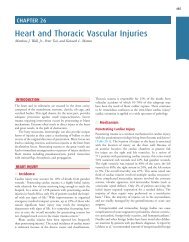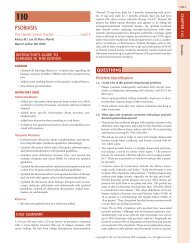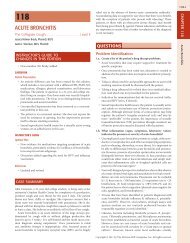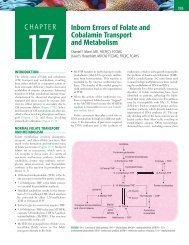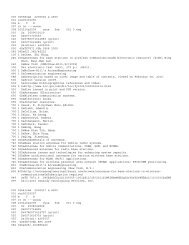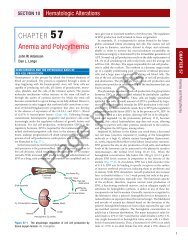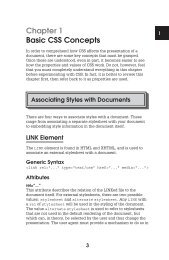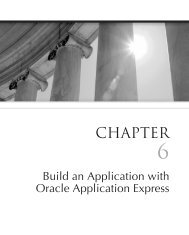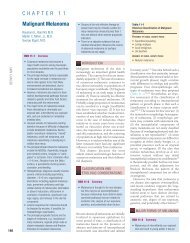Seizures and Epilepsy
Seizures and Epilepsy
Seizures and Epilepsy
Create successful ePaper yourself
Turn your PDF publications into a flip-book with our unique Google optimized e-Paper software.
32 ■ Section 2: Common Pediatric Neurologic Problems<br />
Absence seizures<br />
Absence seizures typically have no preceding aura or<br />
prodrome. An absence seizure usually lasts for only several<br />
seconds to minutes. There is a sudden interruption<br />
of consciousness, staring, 3-Hz blinking, <strong>and</strong> less frequently<br />
automatisms. There is no postictal confusion. 11<br />
The ictal EEG usually consists of 3-Hz generalized<br />
spike <strong>and</strong> wave activity with some slowing of the discharge<br />
frequency during the seizure. The interictal EEG<br />
usually has a normal background. Atypical absence<br />
seizures have generalized spike <strong>and</strong> wave activity but<br />
usually have a frequency less than 3 Hz. 12<br />
Absence seizures typically start between ages 4<br />
<strong>and</strong> 10 years <strong>and</strong> resolve by age 20 years. Atypical<br />
absence epilepsy usually occurs in children who are neurologically<br />
or developmentally abnormal. 13<br />
Febrile seizures<br />
Febrile seizures occur with a prodromal fever. A simple<br />
febrile seizure occurs as a brief generalized tonic clonic<br />
seizure occurring after the onset of fever. A complicated<br />
febrile seizure has prolonged seizure activity or focal<br />
seizure activity. Febrile seizures are covered in detail in<br />
Chapter 4.<br />
Juvenile myoclonic epilepsy<br />
The seizures associated with juvenile myoclonic epilepsy<br />
typically have no preceding aura but may have a prodrome<br />
of morning myoclonus. The seizures may consist<br />
of generalized tonic-clonic activity; however, absence<br />
seizures may also occur. The postictal phase is variable<br />
depending on the seizure type. 11<br />
The ictal EEG usually consists of generalized polyspike<br />
<strong>and</strong> slow wave activity. The interictal EEG is typically<br />
unremarkable. 12<br />
The age of onset of juvenile myoclonic epilepsy is<br />
typically 10 to 20 years. Patients are usually developmentally<br />
<strong>and</strong> neurologically normal. 13<br />
Progressive myoclonic epilepsy<br />
The family of disorders known as the progressive<br />
myoclonic epilepsies (Table 3-3) consists of a number of<br />
loosely related disorders. These epilepsy subtypes are quite<br />
rare <strong>and</strong> have complex presentations <strong>and</strong> diagnostic findings.<br />
Most of these disorders have a genetic basis, though<br />
sporadic cases have occurred in some cases (Table 3-4). The<br />
EEG associated with these disorders is variable. The background<br />
is often slow. The seizures are typically generalized. 11<br />
Infantile spasms<br />
West syndrome typically begins between 3 months <strong>and</strong><br />
3 years of age. 14–16 The seizures associated with West<br />
syndrome consist of a jack-knifing movement <strong>and</strong><br />
myoclonus. The EEG consists of a hypsarrhythmia pattern<br />
with bursts of asynchronous slow waves; spikes <strong>and</strong><br />
Table 3-3.<br />
Progressive Myoclonic Epilepsies<br />
Dentorubral-pallidoluysian atrophy<br />
Juvenile neuroaxonal atrophy<br />
Lafora disease<br />
Late infantile <strong>and</strong> juvenile GM2 gangliosidosis<br />
Myoclonic epilepsy <strong>and</strong> ragged red fibers (MERRF)<br />
Neuronal ceroid lipofuscinosis (NCL) (also known as Batten<br />
disease)<br />
Noninfantile Gaucher disease<br />
Sialidosis<br />
Unverricht–Lundborg disease (Baltic myoclonus)<br />
sharp waves alternate with a suppressed EEG. 17 The clinical<br />
features of West syndrome include infantile spasms<br />
<strong>and</strong> mental retardation, which varies according to the<br />
etiology of the spasms.<br />
Aicardi syndrome is an X-linked disorder present<br />
from birth that is associated with infantile spasms. The<br />
seizures are described as infantile spasms, but alternating<br />
hemiconvulsions may also be seen. The clinical features<br />
of Aicardi syndrome include coloboma, chorioretinal<br />
lacunae, agenesis of the corpus callosum,<br />
vertebral anomalies, <strong>and</strong> seizures. 18<br />
Lennox–Gastaut syndrome<br />
Lennox–Gastaut syndrome typically begins between 1<br />
<strong>and</strong> 10 years of age. There are multiple seizure types,<br />
associated with variable degrees of mental retardation.<br />
The EEG reveals a slow spike wave complex with<br />
a frequency of 1 to 2.5 Hz, multifocal spikes, <strong>and</strong> generalized<br />
paroxysmal fast activity (GPFA). 19<br />
Partial seizures: localization-related epilepsy<br />
Jacksonian motor seizures are simple partial seizures<br />
with no alteration of consciousness. These seizures<br />
begin with tonic contractions of the face, fingers, or feet<br />
<strong>and</strong> transform into clonic movements that march to<br />
other muscle groups on the ipsilateral hemibody. There<br />
is no alteration in consciousness, but postictal aphasia<br />
may occur if the primary epileptogenic zone involves<br />
the dominant hemisphere. Simple partial seizures may<br />
involve autonomic (Table 3-5), sensory, motor, or psychic<br />
functions.<br />
Complex partial seizures<br />
Benign Rol<strong>and</strong>ic epilepsy. Benign Rol<strong>and</strong>ic epilepsy<br />
usually begins between ages 5 <strong>and</strong> 10 years <strong>and</strong> is transmitted<br />
in an autosomal dominant pattern with variable<br />
penetrance. It is fairly common, with an incidence of



